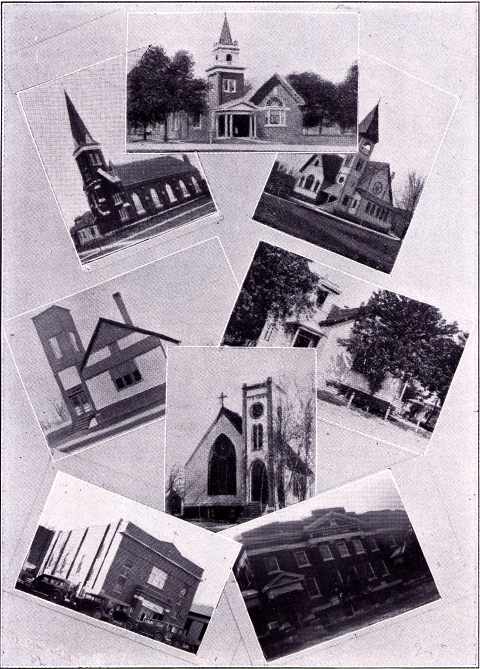
NEGenWeb Project
Church/Catholic
Franciscans

Some Churches at Columbus, Nebraska.
bensiefken, chairman, Fred Bean, Joseph Bender, Henry Schaecher, W. T. Matzen, Ed Lueschen and George C. Anderson. Recognition was also accorded to C. A. Peterson, Hector Blaser, Sr., and N. J. Hemmer, former members of the board, whose early efforts in behalf of the building of the court house are commendable also.
THE GRASSHOPPERS
Scores of articles have been written of the grasshopper plagues in Nebraska. That episode of State history has been talked of so long and often in the homes that it has become a household story of the Plains. A passage or two might be reprinted of the first attack, in-as-
42
![]()
much as, in point of actual and acute suffering, this first visit was the most severe. The handful of farmers then in the county were already struggling hard to work out a living on the prairie, with many miles from the market. It must be remembered that practically all of the salable surplus harvested in Platte, Colfax, Merrick, Boone, Polk and Butler counties had to be hauled overland to the railroad station of Columbus, or the sidetrack landings on either side of Columbus, which later grew into our present towns. Seed and machinery were high, and, besides, these first settlers were met at once with the necessity of building a house and the rest of their farm buildings in the first few years. Lumber was either hewn in the vicinity or purchased and carted for long distances.
THE PESTS IN PLATTE COUNTY
For two weeks in the middle of June, 1875, the grasshoppers visited Platte County, ravaging the countryside to a crisp blackness. Despair was supreme. The slogan, "Eaten out by the 'hoppers. Going East to live with Wife's folks", written on eastbound prairie schooners was a grim reality. The crop was in complete danger. No remedy seemed productive of results despite the labors of all the minds turned towards eradication of the pests. The Columbus Journal of that year offered this remedy, in Editor Turner's own homely language: "Coal oil will kill grasshoppers. After it has been applied they will rub their wings with their legs, try to fly, and keel over on their backs and die."
Grasshopper complaints came in from all over the states of Nebraska, Missouri, Iowa and Kansas. The Governor of Missouri declared a summer Sunday to be set aside as a day of prayer, asking the Master to have mercy on his suffering children. Nebraska churches and societies followed the Missourian's example.
Towards the end of June the pests began to break into Platte County. They left Sherman and Bismark precincts on the morning of Saturday, June 26, 1875, and soon afterwards other sections were abandoned. Rain fell Saturday afternoon and on the next morning, on Sunday, the whole countryside took a renewed lease on life. Sunshine flooded the fields, reviving the plants, and there was great rejoicing all through the county. About half a crop was realized that year, the 'hoppers having left early enough to allow considerable replanting. Subsequent grasshopper attacks perhaps were just as severe as the first, but none exacted such terrible hardships as that first visit in 1875, chiefly, because the settlers were few and poor.
RELIEF FOR THE SUFFERERS
The Platte County Relief Association was formed October 21, 1874, to administer relief to the scattered people that were ravaged by the pests in 1874. Most of the settled counties in the State organized relief associations about this time. At the instigation of governmental bureaus and farmers' societies, these associations gathered food in the East, as well as money, and distributed some gratis and others were supposed to be sold at nominal cost. Unscrupulous men often manipulated these relief associations for their own good and at the expense of the needy. Many complaints came in as to their inefficiency. Platte County's organization was no exception. Mismanagement was charged. It is not our intention to prove or disprove these charges. Suffice it to say that these relief associations did monumental work in places, but were far from being perfect.
WHAT THE UNION PACIFIC DID
The building of the Union Pacific Railroad made Platte County what it is today. Even through the dark years of the Civil War, immigration made its continual trek across the prairie. The close of the War saw this immigration increased a thousandfold. The act of Congress during the Civil War, authorizing the building of the Union Pacific Railroad with government aid, was a great boom, even several years before the road was actually built.
Railroad land, now some of the finest farms to be found anywhere, sold at from two to ten dollars per acre, with a ten-year payment privilege at 6 per cent. Homestead and school sections were averaged at five dollars per acre. Yankees, among the first to settle on the prairie, were slowly pushed out by the more enterprising European farmers, consisting chiefly of Germans, Irish and Scandinavians. To a large extent, the Yankees removed to the new town and grew in wealth with their progress.
A GREAT ENGINEERING FEAT
On December 2, 1863, ground was broken at Omaha for the building of a transcontinental railway that in a few years would revolutionize the transportation of the world. The first earth was removed by Governor Saunders. The first rail was laid in Omaha July 10, 1855. Columbus was reached in 1866.
By the time the Union Pacific construction gangs reached the County limits in May, 1866, they were working in perfect unison, laying ten feet of track per minute, a great engineering feat in that day, and even in this. On June 1, 1866, the track was laid through Columbus and immediate train service was opened to the east. May 10, 1869, the gold spike was driven at Promentary Point in Utah, marking the final completion of the great transcontinental rail-
43
![]()
road, and Platte County received its first regular railroad to the Pacific coast.
THE BURLINGTON AND MISSOURI RAILROAD
In 1879, Platte County voted a bond issue of $100,000 to help finance the construction of the Atchison and Nebraska branch of the Burlington and Missouri Railroad from the north bank of the Platte River to Columbus, a distance of seven miles. The present branch lines of the Union Pacific to Albion and Norfolk, built at first by The Omaha, Niobrara and Black Hills Railroad, were secured by the bond issue of $80,000 issued by Platte County a short time later.
THE GREAT FLOOD AND
THE OMAHA, NIOBRARA AND BLACK HILLS RAILROAD
In the opinion of many old timers, the greatest flood on the Loup occurred March 19, 1881. There was a great loss of live stock and personal property. The wagon bridge south of Columbus was practically destroyed and necessitated the building of an entire new structure. The Union Pacific tracks from Columbus to Duncan, or "Jackson Junction", as it was known then, were much damaged. The Omaha, Niobrara and Black Hills Railroad at that time ran its trains over the Union Pacific rails to Duncan, thence north across the Loup River to "Lost Creek", now extinct. The company's railroad bridge at that point was swept away by the flood, undermining a great part of the foundation and tearing up much track. No trains served Norfolk and Albion over this road for several months, there not being enough money in the Company's coffers to rebuild the bridge.
The Omaha, Niobrara and Black Hills Railroad eventually became part and parcel of the Union Pacific System. The old road bed north of Duncan was abandoned and a new nine-mile line was laid directly northwest from Columbus to Oconee. This is the road now in use.
During the rebuilding of the Columbus wagon bridge, people wishing to cross the Loup had to revert to the old-time ferry. At one time the ferry temporarily broke down and for some time the immigrants and others that had to cross over the swollen river had to do so over the Union Pacific railroad bridge west of town. There was great indignation in Columbus and vicinity because the railroad company exacted the fancy sum of ten dollars per vehicle to cross.
THE PUBLIC SCHOOL SYSTEM
George W. Stevens, a versatile man who did very much for Platte County and Columbus, was the first school teacher for miles around. As a member of the first school board to meet in Columbus in 1860, he offered his services to conduct a public school at Columbus.
Stevens made a survey of the county's school children regularly twice a year. He reported that in 1866 there were 207 school children in the county, as against 154 in 1860. In 1876, when I. N. Taylor wrote his Platte County History, there were 1,677 school children here, which shows what an impetus the building of the Union Pacific gave to the immigrant movement In the West.
THE FIRST SCHOOL REPORT
Through the courtesy of Miss Martha Turner, of The Nebraska Historical Society, we reprint the following extract taken from the First Annual School Report of the State Superintendent, S. D. Beals, for the year ending December 31, 1870. In this extract we find the list of persons teaching in Platte County public schools for the term which ended in June, 1870
|
Days |
Compen- |
|
| Name | on Duty |
sation |
| John H. Spencer | 80 |
$160.00 |
| George W. Brown | 70 |
262.50 |
| Patrick Foley | 41.50 |
|
| Charles Miller | 60 |
120.00 |
| H. H. Fonts | 64 |
96.00 |
| Franz Bachesly | 53 |
53.00 |
| Allice Jones | 60 |
75.00 |
| Minnie Rott | 60 |
75.00 |
| Josephine Wilson | 105.00 |
|
| Hattie Johnson | 60 |
120.00 |
| Julia Wheeler | 103 |
168.00 |
| Clara Bruse | 80 |
200.00 |
| Celestie Fifield | 50 |
125.00 |
(The George W. Brown mentioned above was the father of F. G. Brown, the well-known Union Pacific freight agent in Columbus.)
THE SPANISH-AMERICAN WAR
When President McKinley issued his call to colors at the outbreak of the Spanish-American War, Columbus responded with the organization of Company K of the Nebraska State Militia. This group of soldiers represented enlisted men from over Platte County, the majority being from Columbus.
The personnel of the company consisted of three commissioned officers, Captain J. N. Kilian; First Lieutenant Charles W. Jens and Second Lieutenant Charles L. Stillman; seven noncommissioned officers, First Sergeant James S. Haney; Sergeants Sauer and Albert L. Rollins; Corporals Lester E. Sisson, Harry Rightmire and Louis Schonlau and Musician Charles T. Miner and 53 privates. Company K left Columbus, April 23, 1898, bound for Camp Alvin Saunders at Lincoln.
August Wagner, Columbus attorney, was a
44
![]()
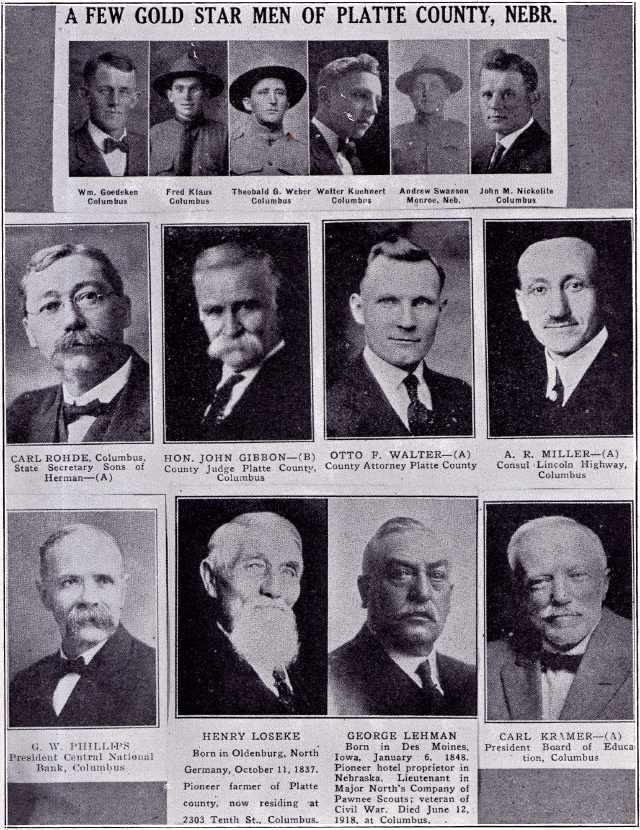
Some Gold Star Boys and Prominent Men of Platte County.
45
![]()
member of this Company and while in the service, presented a continuous pen sketch of its doings to the folks back home. We are indebted to him for the information following.
Company K, part of the First Nebraska Volunteer Infantry, was mustered into Federal service at Lincoln, April 27, 1898. From there the Regiment was sent to Camp Merritt, San Francisco, where training was entered into for several weeks.
The First Nebraska landed in the Philippines, July 10, 1898, at Camp Dewey, near Manila, which city was then occupied by the Spanish. The regiment engaged in a skirmish at Pasay, August 5, 1898, and in the Battle of Manila, August 13, 1898, with the Spanish forces. Most of the fighting was done later on, during the Filipino insurrection. Company K was in the Battle of Manila, February 4, 1899; Nariquina Road, Febr, 17th; San Matea River, Febr. 22nd; Mariquina Road, March 6th; San Francisco Del Monte, March 25th; Mey Canayan, March 26th; Marilao, March 27th; near Marilao, March 29th; Quinquinto, March 30th; Malolos, March 31st; Quinga, April 23, and at Calumpet.
Company K was discharged August 23, 1899, at the Presidio, California. The commanding officer of the First Nebraska Volunteer Infantry Regiment during the Spanish-American War, Colonel John P. Bratt, is still living, residing at 1501 South Ninth Street, Lincoln.
THE DREAM OF IRRIGATION
For 65 years many different interests strove to promote power plants in and about Columbus. The last great effort came in the years 1912, 1913 and 1914. At that time H. E. Babcock, for many years a guiding star in Columbus irrigation projects, representing the Doherty interests, formed the Nebraska Power Company and secured the water rights in the Platte valley.
The company actually built and operated the Genoa power plant at a reputed cost of $35,000. In a report submitted to the state irrigation board, November 25, 1912, the company declared it had spent over $64,000 in that locality, promoting its plans.
As The Nebraska Power Company dreamed of water power for Columbus, it was planned to build the head gates four miles west of the city and erect a huge dam at that place.
Then Arnold K. Koenig and The Central Power Company held up building for many months by litigation in district court concerning priority of water power rights. The Nebraska Power Company finally won its suit, but at considerable cost.
The water power rights of The Nebraska Power Company were sold to H. L. Hollister, of Chicago in 1914. Mr. Hollister visited Columbus and decided to go ahead with the proposed plans. The good citizens of Platte County were startled, when Mr. Hollister placed an order for 450,000 feet of lumber and 14,000 barrels of cement to be used in the construction of the dam. The story becomes hazy after this big order was placed. Hollister left Columbus, the lumber and cement failed to arrive and to this day, the "huge dam, costing $3,000,000" remains to be built.
THE WORLD WAR
The great World War, already waging in Europe since the summer of 1914, had, with each succeeding year, found America drifting nearer and nearer to the fray. Relations with Germany were already broken in February, 1917. The United States Government immediately ordered all buildings and equipment of a public utility nature to be closely guarded.
The first glimpse of war conditions received by the folks in Columbus was the guarding of the Union Pacific railroad bridge west of Columbus. Already in February, 1917, A. P. Groves was patroling (sic) the bridge by day and Chris Nauenberg and Sam Bell, by night.
War with Germany was declared April 6, 1917, and a military patrol was sent at once to guard the railroad bridge, inasmuch as the government considered the bridge to be one of the main arteries in the line of transcontinental transportation. Governor Keith Neville ordered Company H, of the Fourth Infantry, Nebraska Militia, to assume patrol of the key bridge. This company consisted of 48 men from their home station of Madison, and acted entirely under Federal supervision while on duty at the bridge, which was for several months.
A COMPANY OF SOLDIERS IS TALKED ABOUT
It did not take Columbus and Platte County long to realize that the nation was engaged in a mighty war. An immense mass meeting, one of the biggest meetings of its kind ever held in Columbus, was assembled on the evening of April 16, 1917, just ten days after the declaration of war. President Louis Lightner of the Commercial Club was the guiding star of the meeting, which was held at the North Opera House.
The Commercial Club, along with similar organizations, at once fell to the task of assembling a company of soldiers representing Platte County's first volunteers, or at least, most of them. A. L. Rollins and Fred Lanz, both of whom had seen service in the Spanish-American War, as well as other public-spirited men, at once identified themselves with the movement.
46
![]()
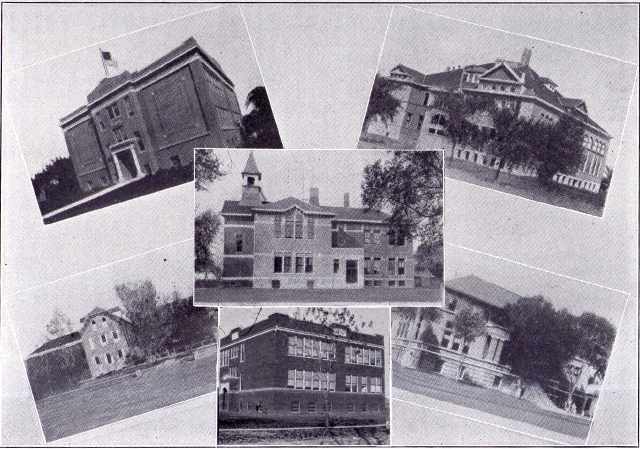
Some of the Schools at Columbus, Nebraska. |
||
Third Ward School. |
Second Ward School. |
Junior High School. |
47
![]()
COMPANY K IS FORMED
A new volunteer regiment, the Sixth Nebraska Infantry, was already being organized in the State. Columbus lost no time in applying for a berth in it. Orders to recruit men for Company K of that regiment were soon received and a group of citizens went out over the County to secure the required enlistments.
The work went on steadily for several weeks. Eventually the commissioned personnel of Company K was designated to be:
Captain: A. L. Rollins.
First Lieutenant: Fred Lanz.
Second Lieutenant: Ed Kavanaugh.
The group of men became Federal troops August 9 1917, and was quartered in Columbus until September 14, 1917, when, with a force of 148 men, Company K was entrained for Camp Cody, New Mexico.
The Sixth Nebraska Regiment went out of existence October 1, 1917, and most of the rank and file of Company K was assigned to the 109th Supply Train. It was with this unit that these volunteer boys eventually did duty in France.
WAR MEASURES AT HOME THE PLATTE COUNTY COUNCIL OF DEFENSE
The Platte County Council of Defense, a patriotic tribunal elected to care for war-time measures and acting partially under orders from a similar State organization, was formed soon after war was declared.
C. J. Garlow was made Chairman; Bruce Webb, vice chairman; Mark Burke, secretary; and W. A. McAllister, treasurer. In the course of the war period the work of the Council of Defense was minute and extensive. A great amount of detail was attended to, and the men appointed to the Board gave liberally of their time in the fulfillment of their duties.
C. L. Gerrard was appointed Food Administrator for Platte County and to him fell the duty of seeing that Platte County did its part in conservation of food. Four-Minute speakers, a group of patriotic orators of which C. J. Garlow was the chairman, was formed in Columbus and did their portion of war work by heightening the patriotic feeling in the territory.
In the Liberty Loan drives instituted by the government to raise money for financing the war, Platte County under-subscribed the first and second quotas, but went over the top in the Baby Bond drive, as well as in the third and fourth drives, so much so that the first and second deficits were entirely wiped out and the County was far to the good.
THE DRAFT IN PLATTE COUNTY
The federal government was not long in declaring a general national selective draft. The registration of men between the ages of 21 and 31 was held June 5, 1917, and in Platte County was under the supervision of Sheriff Mark Burke.
The first contingent of drafted men to leave Platte County numbered five men, Robert Kent, John H. Ross, Edw. W. Brunken, Sylvester Zarek and William Schwantje. They left September 1, 1917, for Camp Funston, Kansas, amid a big flare of patriotism on part of the home folks.
The second contingent of drafted men to leave Platte County also went to Camp Funston, leaving September 22, 1917. The third group, 58 men, left October 6, 1917, and the fourth, with 8 men. This completed the first quota of drafted men.
A second army, called "The Victory Army", was very soon ordered to be formed, and many men left Platte County during the spring and summer of 1918 to join this army. The first contingent of drafted men left April 2, 1918 with 7 men. Then followed in rapid succession: April 30, 1918, 15 men; May 28, 1928, 43 men; June 28, 1918, 58 men; July 22, 1918, 61 men; August 30, 1918, 11 men; September 4, 1918, 3 men; September 5, 1918, 9 men.
It is to be borne in mind, however, that the men of Company K and those that were drafted were not the only men that joined the colors from Platte County. It is probable that the total number will never be entirely ascertained, because a large number of patriotic men enlisted voluntarily at many recruiting offices over the Union and gave their home addresses as "Platte County". Then again, there were many who were working here at the time, enlisted in Platte County, but gave their home station as some other place.
THE MEDICAL WORLD
In the course of the war, six Columbus doctors left their practices to do duty with the armed forces of their country. The first to leave was Dr. W. R. Neumarker, who eventually rose to the rank of Lieutenant-Colonel of a Sanitary Train. The five other doctors were F. H. Morrow, W. S. Evans, C. D. Evans, Jr., North Evans and C. H. Campbell.
THE HOME GUARDS
Falling in line with a nationwide movement, a Platte County organization of Home Guards was formed August 19, 1917. There were five companies recruited in Platte County.
The Home Guards were assembled for the express purpose of taking the place of the State militias and during their enlistment were charged with guarding certain types of places and also to enforce federal, state and local war
48
![]()
time measures. They did invaluable good in their capacity, doing their work without pay.
A donation of $2,500 from the County Board of Supervisors enabled the Home Guards to purchase uniforms and other equipment. The County organization continued its duties until January 10, 1918, when it was mustered out of service.
THE RAVAGES OF THE WAR
The first Platte County boy to die in the service of his country in the World War was Private Fritz Klaus, who left Columbus as a member of Company K. Private Klaus died of pneumonia, February 6, 1918.
The first Platte County boy to be wounded on the battlefields of France was Corporal John Mallet, of Platte Center, who was wounded in a battle northwest of Chauteau-Thierry, July 19, 1918.
George C. Hartman and Lester O. Hartman, two brothers, who were sailors on board the U. S. Destroyer Manley, were the first Columbus boys to lose their lives in the war zone, when their ship went down following a collision with a British warship in English waters, March 19, 1918.
THE LIST OF THE DEAD
By courtesy of Hartman Post, No. 84, American Legion, Columbus, Nebraska, the following list of soldiers and sailors from Platte County made the supreme sacrifice during the World War:
Ben Sueper, St. Bernard.
George H. Mohr, Co. 45, 161st Depot Brigade.
Robert O. Perry, Co. E, 4th Infantry.
Theodore Weber, Co. B, 109th Supply Train.
Julius Trofholz, Battery C, 338th Field Artillery.
Carl A. Walter, Co. B, 109th Supply Train.
Adam H. Bock, Co. 248, 12th Sanitary Train.
Fred Klaus, Co. A, 134th Infantry.
Walter A. Viergutz, 35th Co., 163rd Depot Brigade.
Andrew R. Swanson, 31st Ammunition Train.
William Goedeken, C. C. 163rd Depot Brigade.
Dane Hirt, 378th Casualty Co.
Walter K. A. Kuehnert, Co. F, 131st Infantry.
Geo. C. Hartman, Lester B. Hartman, U. S. N.
John M. Nickolite, Co. C, 362nd Infantry.
Joseph C. Hepday, Co. A, 19th Machine Gun Battalion.
Charles A. Groves, Co. C, 19th Machine Gun Battalion.
Emil Robert, Leigh, Nebraska; Andrew Matya, Tarnov, killed in trench while in action.
John P. Abts, Michael Zuerlein, Max Foltz, Oscar Fenske and Vincent Czerwonka.
This list does not claim completeness as it is very difficult to get information.
The French government, in recognition of the glorious support given to her in her great time of need, prepared and delivered a war memorial certificate to the nearest relative of every soldier and sailor in the American forces who gave his life during the World War. The presentation was made in 1920.
A SOCIETY OF RETURNED SOLDIERS AND SAILORS IS FORMED
The first society of men from Platte County, who had served in the World War, was formed in Columbus, March 8, 1919, and was called "The Temporary Organization of Returned Soldiers, Sailors and Marines." Dr. F. H. Morrow was chairman of the meeting held on that day, and Jay Hensley served as secretary. At the meeting, these two men were elected President and Secretary, respectively. About thirty men joined at that first meeting.
Otto F. Walter, Lowell Walker and Clarence Umland drafted a brief set of by-laws and the organization continued to function until September 20, 1919, when the name was changed to Hartman Post, No. 84, American Legion, with almost 100 men joining the charter class. Dr. F. H. Morrow was elected first Commander of the Post, which was named Hartman Post in memory of the two Hartman brothers, first Platte County boys to lose their lives in the war zone.
SHORT SURVEY OF PRESENT-DAY PLATTE COUNTY STOCK RAISING
Platte County lies in a purely agricultural community, and the products of its farms are practically the sole subsistence of the inhabitants. Before the county was much settled, Platte County raised great numbers of cattle. Its pastures were very fertile and cattle prospered. With the coming of more immigrants, however, this importance in the cattle-raising world diminished, to be increased in the raising of foodstuffs. The number of cattle in Platte County for the past four years has averaged around 50,000 head.
HOG RAISING
Hog raising in this community is done on a large scale. Many of the large fortunes made on the farms in Platte County are due chiefly to this business. The last farm census, taken in 1925, showed Platte County as having 120,000 head of hogs. There are a number of small herds of sheep, but very few in comparison to cattle and hogs. About 22,000 pounds of wool are produced annually.
DAIRYING
The present tendency is towards dairying on a large scale. Over 3,000,000 gallons of milk are
49
![]()
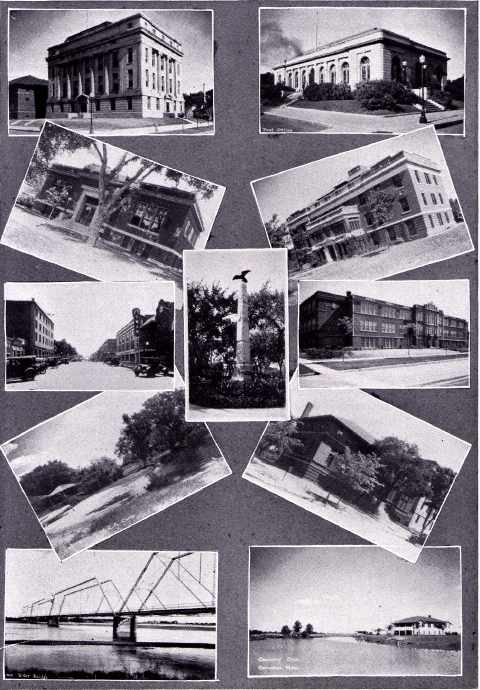
| Scenes and Buildings in Columbus and Vicinity. |
||
The Platte County Court House. |
Soldiers' and Sailors' Monument. |
The Post Office. The Columbus (Evans) Hospital. The Kramer High School. The Y. M. C. A. Building. The Country Club House. |
produced annually in Platte County, about 300,000 pounds of butter being made every year. The Shell Creek Cheese Factory, owned and operated by home interests, is producing much cheese, both for local consumption and inter-county shipment.
CORN AND SMALL GRAINS
Over 155,000 acres of land are annually used in
50
![]()
Platte county for the cultivation of corn, the principal crop. About 3,000,000 bushels of corn are marketed yearly, but a great deal more is cut for silage, fodder and hogged off. The average yield for corn in this territory for the past few years has been from 40 to 45 bushels per acre.
The acreage used in the cultivation of small grains in Platte County is comparatively small. Only about 20,000 acres of wheat are now being sown. The United States census of 1925 showed that 1,500,000 bushels of oats were harvested, while a large amount of the crop was cut and fed unthreshed. In 1925 the census revealed 33,000 bushels of barley and 10,000 bushels of rye harvested. Forty thousand acres are used in the production of hay, most of it being used in local consumption. Alfalfa is the principal hay crop, over 20,000 acres being planted in it. Fifteen thousand acres of wild hay are being cut annually on the farms. In all, over 66,000 acres of hay lands might be found in Platte County.
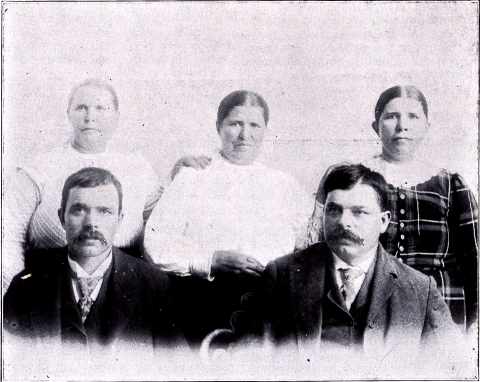
The Augustyn Family.--Sisters and Brothers.
FRUIT GROWING
A survey of the fruit-growing ability of Platte County shows that the apple crop is by far the largest, the growing season being long enough for it to mature nicely. There are about 24,000 trees of bearing age in the County. Some 7,000 apple trees are not yet bearing, it is estimated. About 20,000 bushels is the average crop. Grapes, plums, prunes, peaches and pears also grow in various quantities.
The United States census of 1925 reported that there were at that time 2,141 farms in Platte County, with a total farm acreage of 400,760, of which 302,756 acres were used in the raising of crops. The total value of all farm property was placed at $65,324,473, of which $48,284,097 represented the total value of land on farms.
The length of the growing season in Platte County, figured from the last killing frost in the spring to the first killing frost in the autumn, has ranged during the past ten years from 138 days in 1921 to 176 in 1925.
51
![]()
|
|||